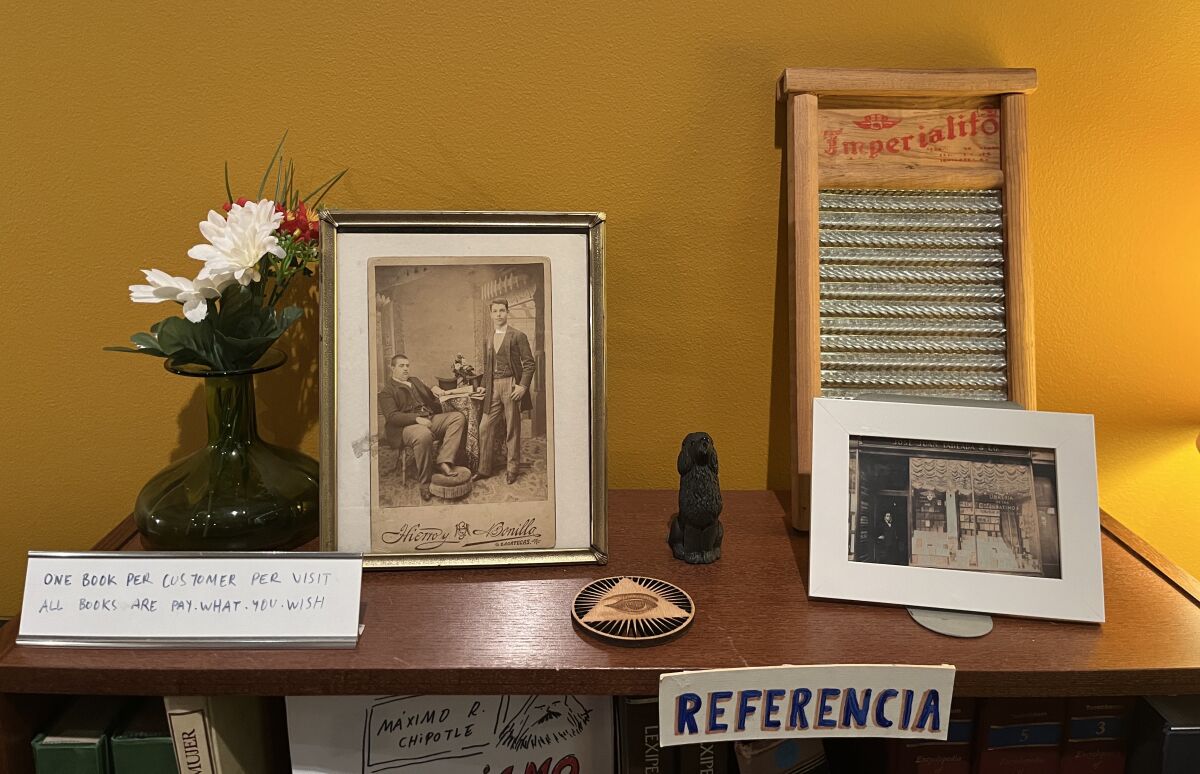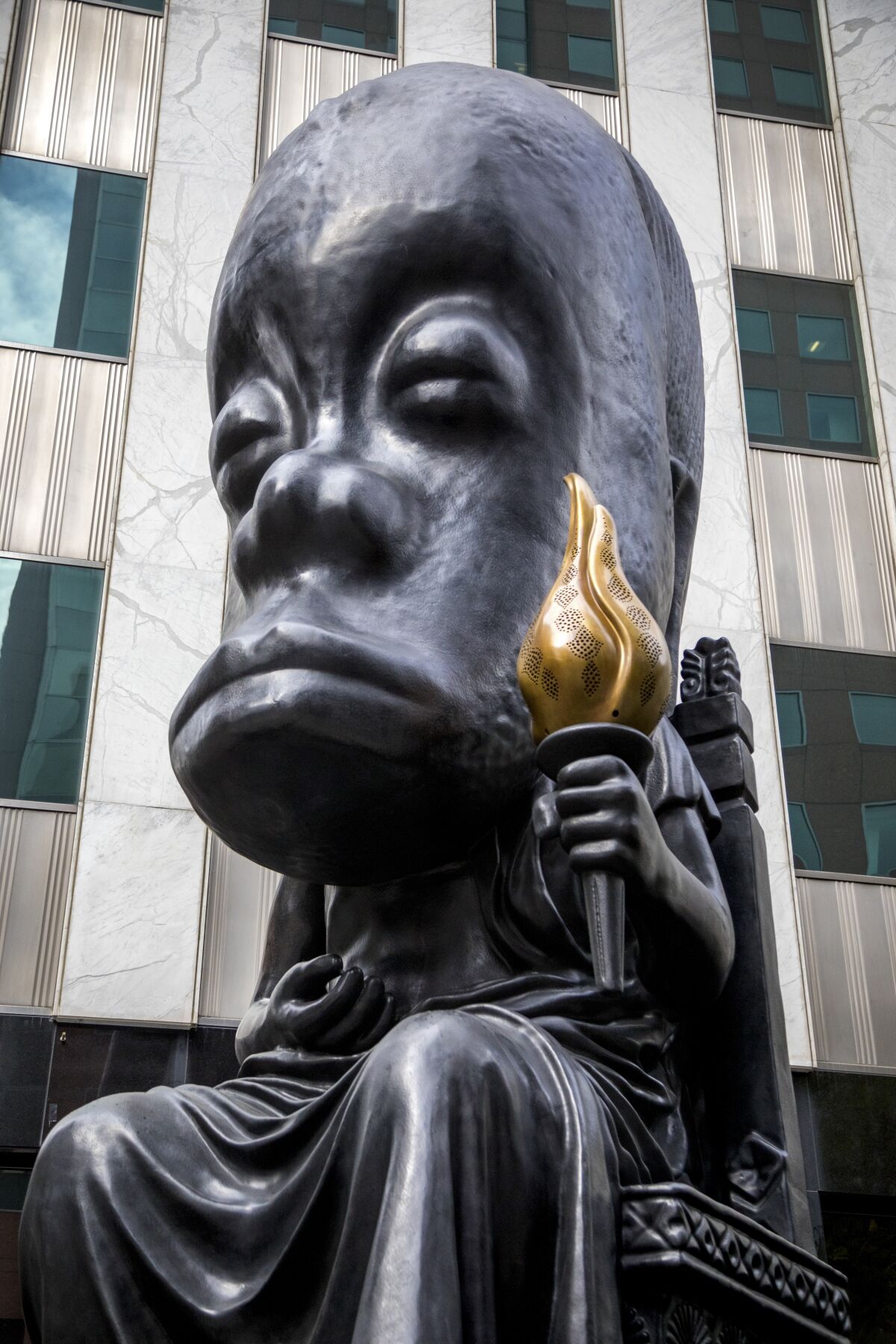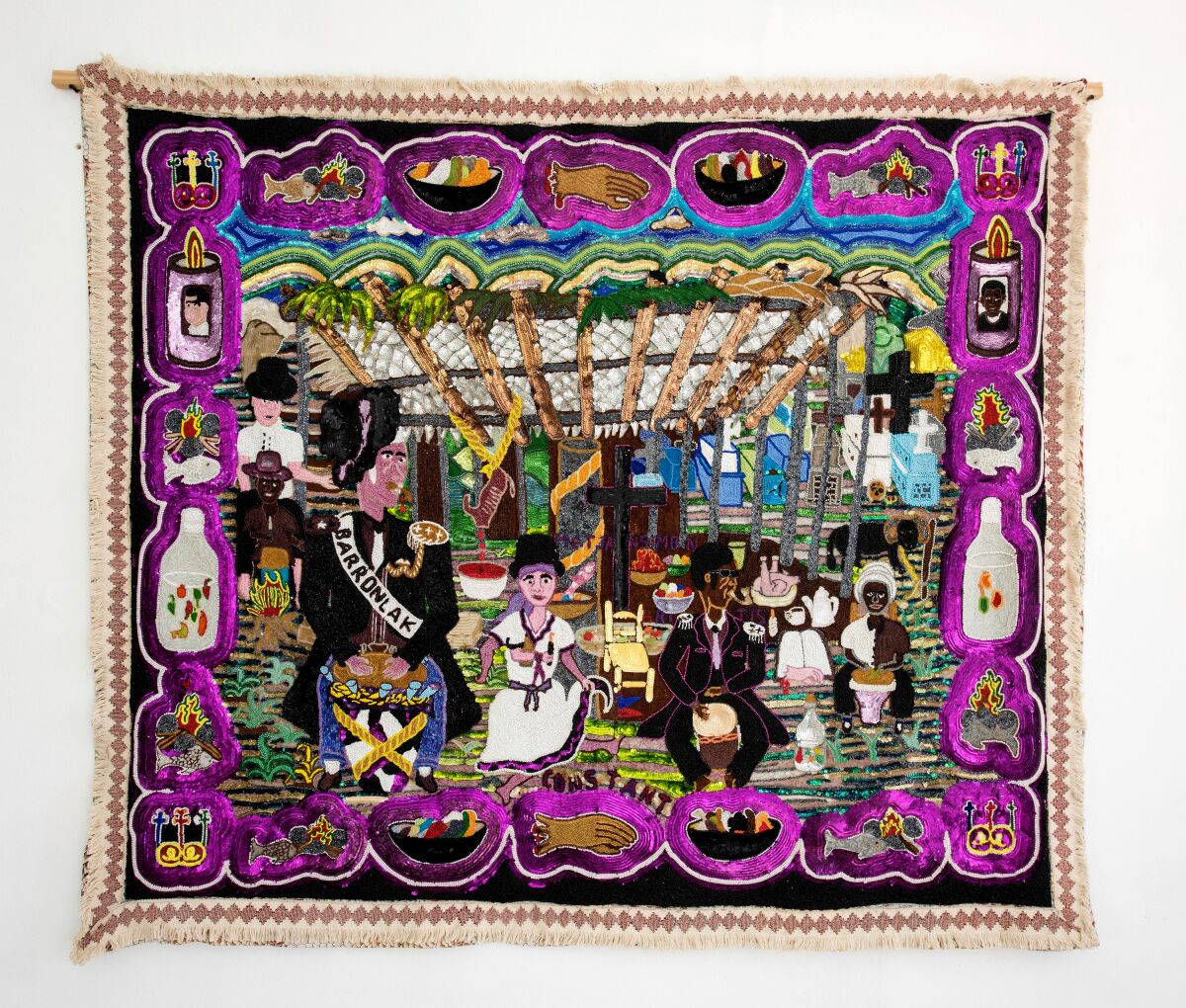It’s Friday, and I’m thinking about bourekas and crispy tacos and the small matter of a certain indictment. I’m Carolina A. Miranda, arts and design columnist at the Los Angeles Times, with the week’s essential arts news and Pedro Pascal memes:
A hidden bookshop
I love nothing more than a used bookstore. Cluttered shelves. The smell of musty paper. An owlish owner who happens to know what’s in that teetering tower by the door. So, as I was making the rounds last weekend, I was very pleasantly surprised to run into Pablo Helguera’s “Librería Donceles” at the Vincent Price Art Museum at East L.A. College. (Yes, I’m still frantically catching up on all the art happenings I missed while on leave!)
Helguera is a New York-based artist and educator who produces one of my favorite newsletters, “Beautiful Eccentrics,” which ruminates on an array of cultural themes. (His most recent missive is about staging an event and having no one show up. It is poignant, as always.) I’ve been reading about his “Librería Donceles” project for years: a socially driven art installation that is essentially a roving Spanish-language bookstore.

Pablo Helguera’s “Librería Donceles” features all the little touches you might find in a small, independent used bookshop.
(Carolina A. Miranda / Los Angeles Times)
“Librería Donceles” has previously materialized in cities such as San Francisco, Boston and Indianapolis. In many locations, it is often the only Spanish-language bookstore in town. On the Eastside of Los Angeles, where it is currently installed, it has the company of great shops such as Libros Schmibros in Boyle Heights (which is also a lending library) and Other Books (also in Boyle Heights), which I love for the selection of artist books. But neither outpost is exclusively Spanish-language, which makes “Donceles” unique.
Helguera writes that he is inspired by books — not just the knowledge they contain, but as physical objects. “To me the relationship with the object of the book was not only educational and practical,” he wrote in 2017, “but also emotional and symbolic.”
The name “Donceles” is drawn from the Mexico City street known for its cluttered used bookshops. “As a student, I frequented the Donceles bookstores in particular,” he adds, “both because books were cheap and because I enjoyed the thrill of the chase, the hunting expedition through a labyrinth of books that would eventually yield a gem, a book so valuable that even the bookseller would not know what it was.”
Newsletter
Your essential guide to the arts in L.A.
Get Carolina A. Miranda’s weekly newsletter for what’s happening, plus openings, critics’ picks and more.
You may occasionally receive promotional content from the Los Angeles Times.
The installation at VPAM channels the vibe of those dusty shops found in Latin American capitals: from the wildly eclectic tomes (self-help, literature, outdated sci-fi) to the chess boards that visitors are welcome to employ for matches to the soundtrack (which was a combination of boleros and Peruvian landó when I happened through).
You are welcome to browse, hang out and can buy a book by donation (funds go to the great Libros Schmibros) or, conversely, you are invited to donate your Spanish-language books. I managed to pick up a great tome on Frida Kahlo by esteemed Mexican critic Raquel Tibol during my visit. A terrific score.
Read more about why Helguera created the work in his essay “A Vicarious Learning.” The installation is on view at the Vincent Price Art Museum through June 24, vincentpriceartmuseum.org.
In the galleries
That time Madonna drove Jean-Michel Basquiat and Larry Gagosian around L.A. because no one else could drive. Or the regular visits Basquiat made to Gemini G.E.L. to watch Robert Rauschenberg work on prints. As “Jean-Michel Basquiat: King Pleasure” opens in downtown L.A., The Times’ Deborah Vankin digs into the time Basquiat spent in L.A. She also talks to his sisters, Lisane Basquiat and Jeanine Heriveaux, who organized the show. “He wasn’t just this dude who sprung up from the streets, like his story began when he left home,” says Lisane. “He actually came from a family. And there was a lot of love in our home.”

“Jean-Michel Basquiat: King Pleasure,” now open at the Grand L.A., was produced by his sisters, Lisane Basquiat, left, and Jeanine Heriveaux.
(Christina House / Los Angeles Times)
I dig into the issue of museum seating with my first-ever museum seating report card: “Some beckon the sitter with backrests and velvety upholstery; others offer all the comfort of a Calvinist pew, demanding that you sit ramrod straight — apparently the ideal posture for experiencing the wrath of God or contemporary video artists.” Find out who got an A and who is getting held back for the year.
If, like me, you are a seating geek, may I highly recommend the Instagram account @museumseats.
Times critic Christopher Knight had a look at the freshly revamped and expanded Hammer Museum, which over the course of the last two decades, as he writes, “has dramatically transitioned from a vanity-fueled embarrassment to a vibrant cultural institution.” He has a look at their permanent collection show, “Together in Time: Selections From the Hammer Contemporary Collection,” which was organized by a curatorial team led by the Hammer’s director, Ann Philbin, and chief curator Connie Butler.

Sanford Biggers’ “Oracle,” 2021, occupies a new terrace at the Hammer Museum.
(Ricardo DeAratanha / Los Angeles Times)
Classical notes
Debussy’s 1902 opera “Pelléas et Mélisande,” writes Times classical music critic Mark Swed, is “a study of obfuscation and its consequences, an opera not of buoyant ‘La Bohème’ Parisians with fantasies of greatness in their miserable garrets but characters disillusioned by fantasies in the presence of fate and nature.” Though this production by L.A. Opera was imported from Scottish Opera, he writes, this is “a decidedly American ‘Pelléas’ in its own right.”

Geneviève (sung by Susan Graham), left, and Mélisande (Sydney Mancasola) in a scene from Debussy’s “Pelléas et Mélisande.”
(Francine Orr / Los Angeles Times)
Composer Reena Esmail has been artist-in-residence with the Master Chorale, and her first commission, appropriately enough, is all about water. “A Requiem for Water” is inspired by California’s water crisis — and synthesizes Western classical music with Indian ragas. “Her work,” writes Tim Greiving, “is a duet between traditions, where classically notated orchestral and chamber ensembles dance with improvised, microtonal Hindustani vocals, sitars and violins.”
On and off the stage
My colleague Jessica Gelt spent her 20s touring in indie rock bands. (Here’s her band’s MTV Spain debut.) So she has a true insider’s perspective on the Geffen Playhouse’s world-premiere musical “The Lonely Few,” which is about indie rock musicians. Some things were immediately different from a true rock show — like the usher who hands patrons earplugs. “When you show up at a real dive bar to see a real indie band, nobody hands you earplugs,” she writes, “and the person at the door taking your money could not care less if your ears bleed.” But how else does the show stack up? Well, you’ll have to read her report to find out.
ICYMI, here is theater critic Charles McNulty’s review of the show.
Enjoying this newsletter? Consider subscribing to the Los Angeles Times
Your support helps us deliver the news that matters most. Become a subscriber.
As Gelt was rocking out, McNulty was immersing himself in an immersive production of “The Tempest,” a collaboration between the Shakespeare Center of Los Angeles and After Hours Theatre Company. Visitors can wander about the set, but there are sit-down portions of the action too. Directed by Ben Donenberg, the show “allows political interpretations to arise through the particular qualities and life experiences of his actors. The approach is pluralistic.”

Chris Butler, right, brings a “ruthless unsentimentality” to the role of Prospero, writes McNulty.
(Brian Hashimoto)
Design time
The amount of water featured in the architectural renderings for the Disney community in Rancho Mirage is giving me agita. Have we learned nothing?

The designers of Cotino, the Disney community planned for Rancho Mirage, appear not to have heard of this phenomenon called a megadrought.
(Walt Disney Imagineering)
The Times is unveiling a new newsletter called “You Do ADU” that is all about how to conceive, design, permit and build an ADU — one of the more common forms of new housing in L.A. — and it will be hosted by my colleague Jon Healey.
Design writer Lisa Boone, in the meantime, has a look at an ADU project that has helped bring a Chilean Ukrainian family together — and served as emergency housing for refugees fleeing the Russian invasion of Ukraine.
Essential happenings
Matt Cooper has all the happenings organized by neighborhood, including a ballet inspired by Laura Esquivel‘s novel “Like Water for Chocolate” at the Segerstrom in Costa Mesa and a new showcase from L.A. Dance Project in downtown L.A.
Steven Vargas has the essential going-out guide, with dance theater, Haitian “drapo” tapestries and a play centered on Vietnamese cooking — and all the politics that implies.

A drapo tapestry by Myrlande Constant, Baron Lakwa and Met Jan Simon at the Fowler Museum.
(George Echevarria / Myrlande Constant / Central Fine)
Moves
L.A. author Carribean Fragoza was one of 10 writers to be bestowed with a Whiting Award this week. To mark the occasion, she and I had a terrific conversation about writing and female interiority. “I am fascinated by the scowl, the unsmiling aspect of little girls, when they’re young enough that they can’t be made to smile if they don’t want to,” she tells me. “I’m interested in protecting that.”
Passages
Ann Wilson, the last of the Coenties Slip artists of Lower Manhattan, a group that included painters such as Agnes Martin and Ellsworth Kelly, has died at 91.
The L.A.-based designer Suzanne Rheinstein, known for the classic interiors she designed for the patron class, is dead at 77.
Ethiopian pianist and composer Emahoy Tsegué-Maryam Guèbrou, who spent much of her life in a monastery, and whose music has appeared in Oscar-nominated films, has died at 99.
In the news
— Matt Pearce has a terrific essay on the death of Twitter, which he likens to a dead mall.
— Speaking of dead malls, I’m belatedly catching up on “The Last of Us” and really enjoyed the episode that takes place in a mall. Slate’s Nadira Goffe wrote on why this was a poignant location.
— If I had to synthesize architecture critic Oliver Wainwright‘s review of Eric Owen Moss’ “(W)rapper” building in Culver City in only four words, it’d be: “hell to the no.”
— Pro-Putin artists shunned by Western institutions are finding an audience in places such as China, Serbia and the United Arab Emirates.
— A Roman statue of Septimius Severus has been seized from the Metropolitan Museum after investigators said it had been stolen from an archaeological site in Turkey. Other items were also seized.
— In much happier news, the Compton Art & History Museum opened last month. And William Poundstone paid a visit.
— The obsessive Greg Allen catalogs all the artworks shown in a well-known photograph of a young Robert Rauschenberg.
— Henri Cartier-Bresson‘s photographs of New Jersey.
And last but not least …
Pedro Pascal as mushrooms.

